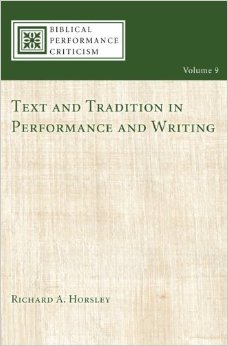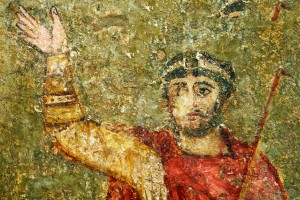Richard Horsley’s, Text and Tradition in Performance and Writing, is volume nine of the Wipf and Stock series Biblical Performance Criticism. Due to significant overlap in the content of several of the chapters, I have elected to sketch the book’s general contours rather than offer a chapter by chapter summary.
The foundational assertion of the book is that biblical scholarship seriously needs to rethink what it means by “text” (xv). According to Horsley, modern scholarship remains firmly entrenched in the anachronistic assumptions of “print culture” (1). Print culture assumes that “text” is a fixed entity, which could be readily consulted and/or cited by later writers. Horsley argues, however, that since the ancient world was an “oral culture,” written texts were vastly less significant than oral texts/traditions. To support this argument, he adduces several lines of evidence. First, recent studies on ancient literacy indicate that only about 10% of the population was literate. Second, it is likely that most people did not have access to written texts (3, 113-14, etc.). Written texts were the sole possession of the elite, and there is little evidence to suggest that the “ordinary” people had any real engagement with the literati (11-13, 114, etc.). Third, even among the literate, scribal culture, the evidence suggests that “texts” were primarily encountered through oral instruction and memorization (9-11, 53-98). Fourth, textual pluriformity in the earliest manuscripts of what became the “Hebrew Bible” suggest that written texts in the later Second Temple period were fluid rather than stable (7-8, 47, etc.).
The realization that scribal culture was primarily an oral culture has major implications. For one, it implies a move away from the notion that writers were directly citing written texts. Further, the citation formula, “it is written” (gegrapti), is not a signifier that a written text is being cited, but rather a rhetorical appeal to a venerated, that is, authoritative, tradition (passim). Even in an environment such as Qumran, citations of and/or direct interaction with written texts are minimal (48-51). In addition, because scribes carried texts primarily on “tablets of the heart” (memory), it is inappropriate to speak of certain works as “re-written Bible” (108). Finally, the premise that written texts are the product of scribal culture is of paramount importance for Horsley. Scribal culture, by its very nature, was elitist and conservatory of the status quo (i.e. the “great tradition,” of which ben Sira is but one example, 83). When scribal circles felt threatened, they could rebel by producing alternative Torah traditions (107-113). However, this is to be distinguished from the type of encounter with “text” that we see among the common people.
When one pushes beyond scribal culture to popular culture, “text” becomes even more definitively an oral/aural communicative event. Almost all written texts give us only indirect access to the beliefs and hopes of the common people (traditions preserved in the Gospels appear to be an exception, 116). Horsley believes that within both the “Hebrew Bible” as well as Josephus, it is possible to detect “windows” into the traditions of the people (i.e. the “little tradition,” e.g. 100-1, 115, 163-4, 171, etc.). These “little/popular traditions” are the oral traditions, shaped by the continual telling and re-telling of stories about key events (e.g. Exodus) and key figures (e.g. Moses, Joshua, and David) that would come to be, in part, preserved in scribal texts.
For Horsley, the canonical Gospels are our most immediate access into these popular traditions. In particular, he believes that Mark and Q “clearly derive from circles of ordinary people” (116). Mark’s Gospel depicts Jesus in the popular role of a prophet, whose ministry represents the climax of Israel’s story over and against the elitist, scribal, Temple regime. The Gospel’s current written form bears witnesses to numerous layers of oral “performances.” Eventually, numerous performances of various and sundry traditions came together to form a \coherent narrative that became the Gospel of Mark (276).
For Horsley, one of the benefits of performance criticism is a shift away from the meaning of a written text to the meaning effect that an oral text would have on an audience located in a concrete socio-political context. Following the lead of John Miles Foley, he employs the categories of text, context, and register. Oral texts are communicative units (158, 178, etc.) that offer “patterns that inform group identity” (233). It is within a specific socio-political context (Foley’s “performance arena”) that an orator “performs” a text. The “performer,” herself/himself a member of the community, articulates the text in the “appropriate register” (160). When this happens, the text “metonymically references” the community’s larger store-house of oral tradition. This model of communication highlights the socio-political contingency of every communicative event. Each performance of the “text” in uniquely tailored to its context.
While this book represents an important scholarly contribution, there are areas that warrant critical attention. The first is stylistic. Parts of the book cross the line between clarifying repetition and the domain of utter redundancy. The opening chapter in the book (1-30) provides ample foundation for taking the claim that the ancient world was an oral culture seriously. It is not necessary, therefore, to spend the opening pages of every subsequent chapter recapitulating the evidence. With respect to the book’s content, there are times when Horsley could be accused of pushing the evidence too far. For example, textual pluriformity among the “biblical” manuscripts at Qumran does not necessitate the conclusion that written texts were not regularly being consulted. Finally, it remains a bit of a mystery what exactly “Mark” is for Horsley. At what point exactly did Mark become Mark? Was it when tradition units were performed in the nascent “Markan community?” Was it when the Gospel’s general narrative shape took form? Or, was it in the fourth century when written standardized copies became widely available (301)? Further, now that the text is fixed, what exactly is “Mark” today? If it is any and every oral performance, for which “Mark” are performers to be held responsible?
The Bottom Line: Horsley’s study offers an impressive synthesis of evidence from a number of cognate fields, arguing for a “paradigm shift” in biblical studies towards an understanding of “text” as primarily an oral/aural communicative event. Recommended for those interested in the performance criticism and the implications of recent studies on orality for biblical studies.
Reviewed by Max A. Botner (mb274@st-andrews.ac.uk)
University of St Andrews





Leave a Reply
Your email is safe with us.